NSM5RFN Critical Review: Analysis of a Quantitative Research Study
VerifiedAdded on 2021/06/17
|8
|2861
|27
Homework Assignment
AI Summary
This document presents a critical review of a quantitative study titled "The combined effects of cold therapy and music therapy on pain following chest tube removal among patients with cardiac bypass surgery." The review, conducted by a student, evaluates the study's purpose, literature review, design (a randomized control trial), sample, ethical considerations, outcome measures, intervention details, results, and conclusions. The study investigated the effectiveness of cold therapy, music therapy, and their combination in reducing pain after chest tube removal. The review assesses the clarity of the research question, the appropriateness of the study design, potential biases, and the validity of the findings. The results indicated that the combined therapy was effective in reducing pain; however, the individual interventions did not show significant pain reduction. The review discusses the clinical importance of the results and the limitations of the study, emphasizing implications for nursing and midwifery practices. The review also highlights the statistical significance and clinical relevance of the study's findings, providing a comprehensive analysis of the research methodology and outcomes.
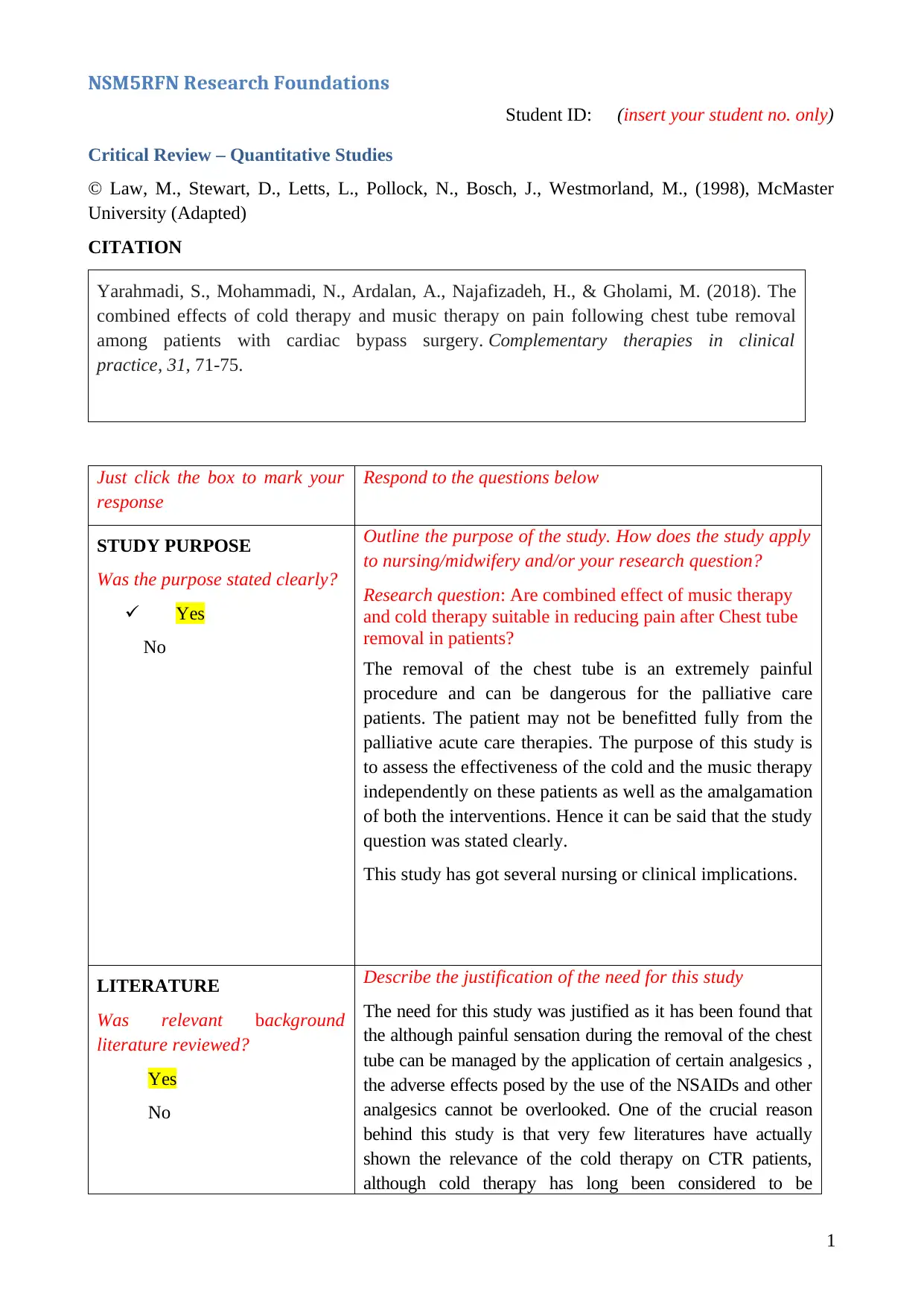
NSM5RFN Research Foundations
Student ID: (insert your student no. only)
Critical Review – Quantitative Studies
© Law, M., Stewart, D., Letts, L., Pollock, N., Bosch, J., Westmorland, M., (1998), McMaster
University (Adapted)
CITATION
Yarahmadi, S., Mohammadi, N., Ardalan, A., Najafizadeh, H., & Gholami, M. (2018). The
combined effects of cold therapy and music therapy on pain following chest tube removal
among patients with cardiac bypass surgery. Complementary therapies in clinical
practice, 31, 71-75.
Just click the box to mark your
response
Respond to the questions below
STUDY PURPOSE
Was the purpose stated clearly?
Yes
No
Outline the purpose of the study. How does the study apply
to nursing/midwifery and/or your research question?
Research question: Are combined effect of music therapy
and cold therapy suitable in reducing pain after Chest tube
removal in patients?
The removal of the chest tube is an extremely painful
procedure and can be dangerous for the palliative care
patients. The patient may not be benefitted fully from the
palliative acute care therapies. The purpose of this study is
to assess the effectiveness of the cold and the music therapy
independently on these patients as well as the amalgamation
of both the interventions. Hence it can be said that the study
question was stated clearly.
This study has got several nursing or clinical implications.
LITERATURE
Was relevant background
literature reviewed?
Yes
No
Describe the justification of the need for this study
The need for this study was justified as it has been found that
the although painful sensation during the removal of the chest
tube can be managed by the application of certain analgesics ,
the adverse effects posed by the use of the NSAIDs and other
analgesics cannot be overlooked. One of the crucial reason
behind this study is that very few literatures have actually
shown the relevance of the cold therapy on CTR patients,
although cold therapy has long been considered to be
1
Student ID: (insert your student no. only)
Critical Review – Quantitative Studies
© Law, M., Stewart, D., Letts, L., Pollock, N., Bosch, J., Westmorland, M., (1998), McMaster
University (Adapted)
CITATION
Yarahmadi, S., Mohammadi, N., Ardalan, A., Najafizadeh, H., & Gholami, M. (2018). The
combined effects of cold therapy and music therapy on pain following chest tube removal
among patients with cardiac bypass surgery. Complementary therapies in clinical
practice, 31, 71-75.
Just click the box to mark your
response
Respond to the questions below
STUDY PURPOSE
Was the purpose stated clearly?
Yes
No
Outline the purpose of the study. How does the study apply
to nursing/midwifery and/or your research question?
Research question: Are combined effect of music therapy
and cold therapy suitable in reducing pain after Chest tube
removal in patients?
The removal of the chest tube is an extremely painful
procedure and can be dangerous for the palliative care
patients. The patient may not be benefitted fully from the
palliative acute care therapies. The purpose of this study is
to assess the effectiveness of the cold and the music therapy
independently on these patients as well as the amalgamation
of both the interventions. Hence it can be said that the study
question was stated clearly.
This study has got several nursing or clinical implications.
LITERATURE
Was relevant background
literature reviewed?
Yes
No
Describe the justification of the need for this study
The need for this study was justified as it has been found that
the although painful sensation during the removal of the chest
tube can be managed by the application of certain analgesics ,
the adverse effects posed by the use of the NSAIDs and other
analgesics cannot be overlooked. One of the crucial reason
behind this study is that very few literatures have actually
shown the relevance of the cold therapy on CTR patients,
although cold therapy has long been considered to be
1
Paraphrase This Document
Need a fresh take? Get an instant paraphrase of this document with our AI Paraphraser
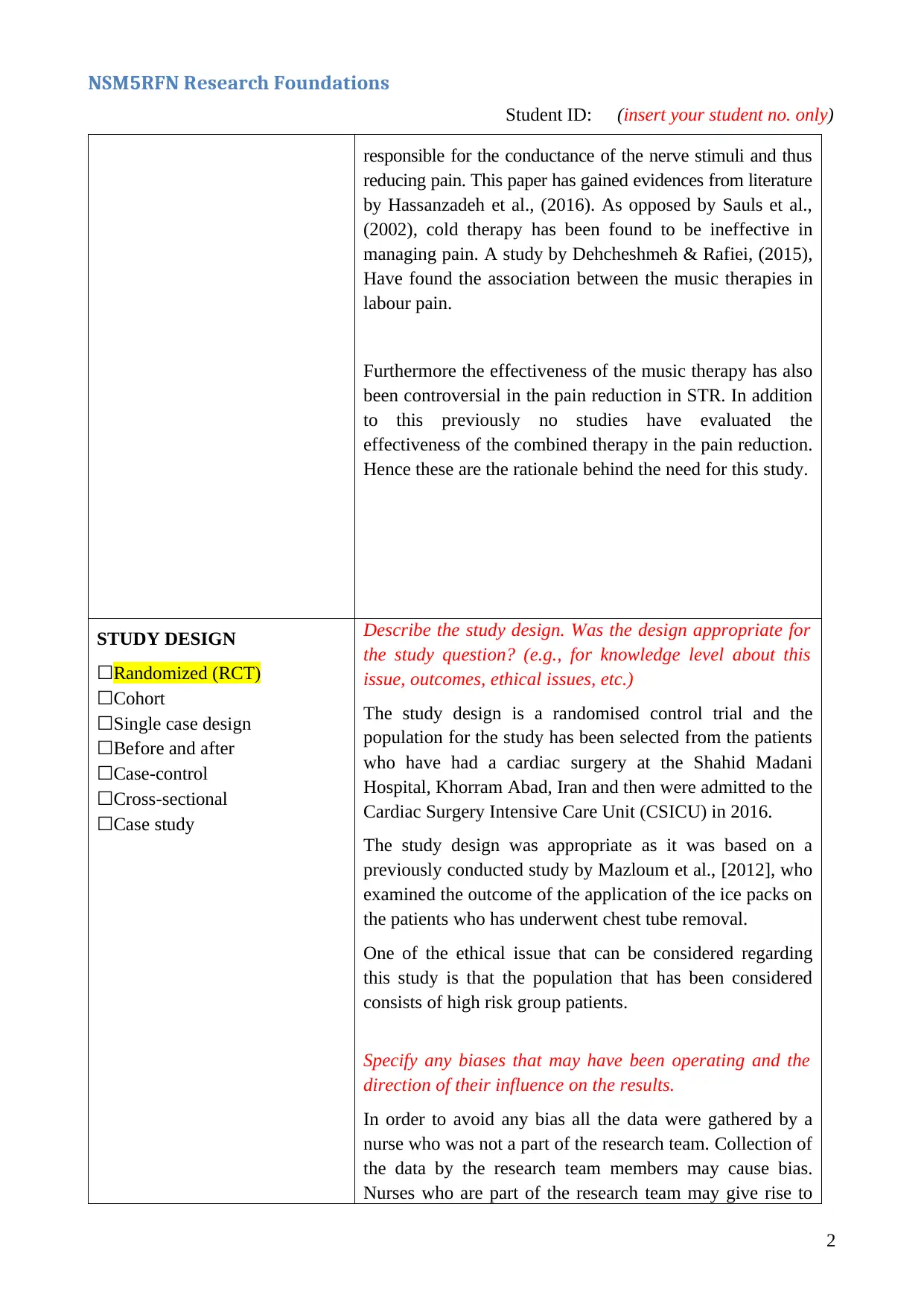
NSM5RFN Research Foundations
Student ID: (insert your student no. only)
responsible for the conductance of the nerve stimuli and thus
reducing pain. This paper has gained evidences from literature
by Hassanzadeh et al., (2016). As opposed by Sauls et al.,
(2002), cold therapy has been found to be ineffective in
managing pain. A study by Dehcheshmeh & Rafiei, (2015),
Have found the association between the music therapies in
labour pain.
Furthermore the effectiveness of the music therapy has also
been controversial in the pain reduction in STR. In addition
to this previously no studies have evaluated the
effectiveness of the combined therapy in the pain reduction.
Hence these are the rationale behind the need for this study.
STUDY DESIGN
☐Randomized (RCT)
☐Cohort
☐Single case design
☐Before and after
☐Case-control
☐Cross-sectional
☐Case study
Describe the study design. Was the design appropriate for
the study question? (e.g., for knowledge level about this
issue, outcomes, ethical issues, etc.)
The study design is a randomised control trial and the
population for the study has been selected from the patients
who have had a cardiac surgery at the Shahid Madani
Hospital, Khorram Abad, Iran and then were admitted to the
Cardiac Surgery Intensive Care Unit (CSICU) in 2016.
The study design was appropriate as it was based on a
previously conducted study by Mazloum et al., [2012], who
examined the outcome of the application of the ice packs on
the patients who has underwent chest tube removal.
One of the ethical issue that can be considered regarding
this study is that the population that has been considered
consists of high risk group patients.
Specify any biases that may have been operating and the
direction of their influence on the results.
In order to avoid any bias all the data were gathered by a
nurse who was not a part of the research team. Collection of
the data by the research team members may cause bias.
Nurses who are part of the research team may give rise to
2
Student ID: (insert your student no. only)
responsible for the conductance of the nerve stimuli and thus
reducing pain. This paper has gained evidences from literature
by Hassanzadeh et al., (2016). As opposed by Sauls et al.,
(2002), cold therapy has been found to be ineffective in
managing pain. A study by Dehcheshmeh & Rafiei, (2015),
Have found the association between the music therapies in
labour pain.
Furthermore the effectiveness of the music therapy has also
been controversial in the pain reduction in STR. In addition
to this previously no studies have evaluated the
effectiveness of the combined therapy in the pain reduction.
Hence these are the rationale behind the need for this study.
STUDY DESIGN
☐Randomized (RCT)
☐Cohort
☐Single case design
☐Before and after
☐Case-control
☐Cross-sectional
☐Case study
Describe the study design. Was the design appropriate for
the study question? (e.g., for knowledge level about this
issue, outcomes, ethical issues, etc.)
The study design is a randomised control trial and the
population for the study has been selected from the patients
who have had a cardiac surgery at the Shahid Madani
Hospital, Khorram Abad, Iran and then were admitted to the
Cardiac Surgery Intensive Care Unit (CSICU) in 2016.
The study design was appropriate as it was based on a
previously conducted study by Mazloum et al., [2012], who
examined the outcome of the application of the ice packs on
the patients who has underwent chest tube removal.
One of the ethical issue that can be considered regarding
this study is that the population that has been considered
consists of high risk group patients.
Specify any biases that may have been operating and the
direction of their influence on the results.
In order to avoid any bias all the data were gathered by a
nurse who was not a part of the research team. Collection of
the data by the research team members may cause bias.
Nurses who are part of the research team may give rise to
2
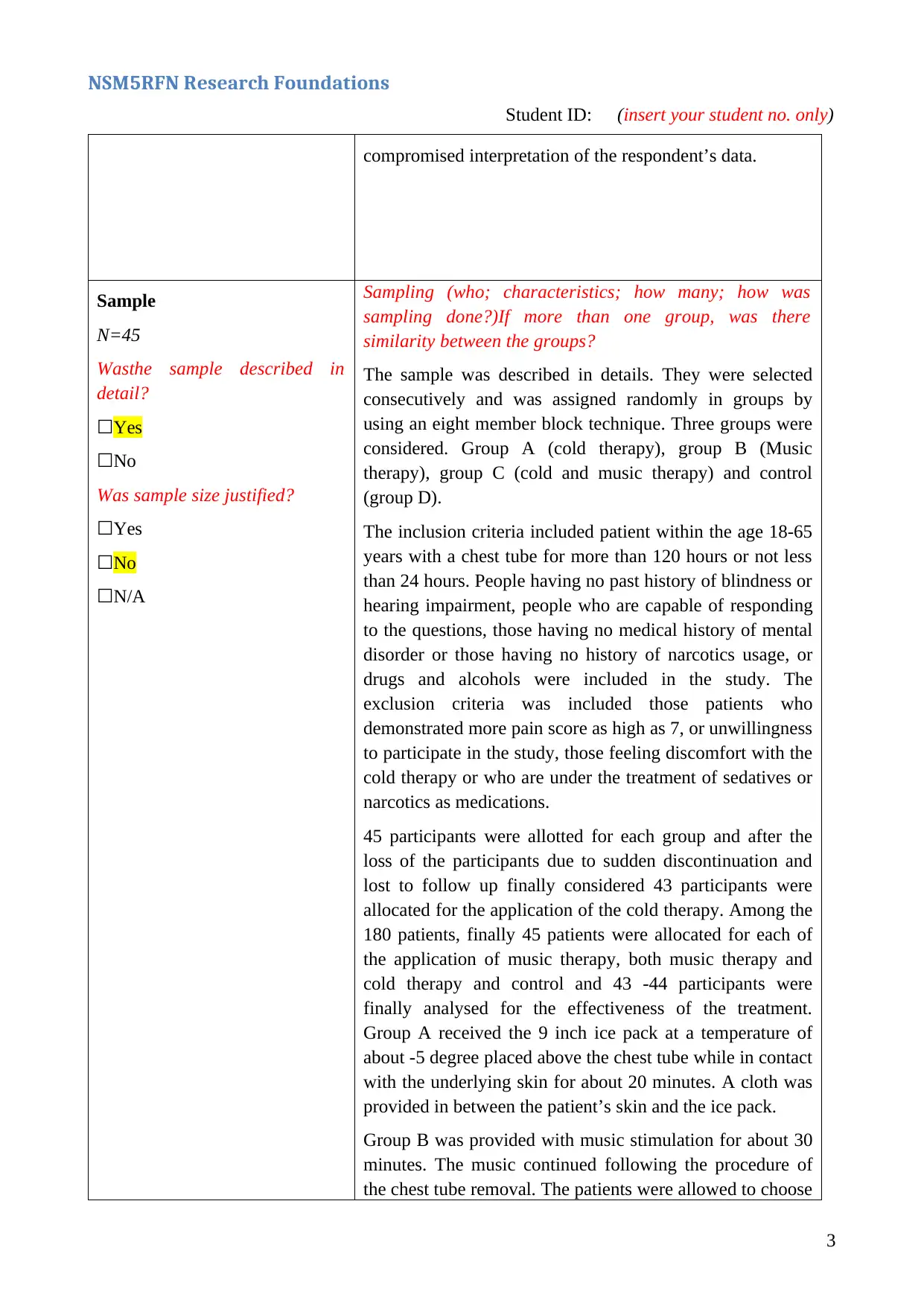
NSM5RFN Research Foundations
Student ID: (insert your student no. only)
compromised interpretation of the respondent’s data.
Sample
N=45
Wasthe sample described in
detail?
☐Yes
☐No
Was sample size justified?
☐Yes
☐No
☐N/A
Sampling (who; characteristics; how many; how was
sampling done?)If more than one group, was there
similarity between the groups?
The sample was described in details. They were selected
consecutively and was assigned randomly in groups by
using an eight member block technique. Three groups were
considered. Group A (cold therapy), group B (Music
therapy), group C (cold and music therapy) and control
(group D).
The inclusion criteria included patient within the age 18-65
years with a chest tube for more than 120 hours or not less
than 24 hours. People having no past history of blindness or
hearing impairment, people who are capable of responding
to the questions, those having no medical history of mental
disorder or those having no history of narcotics usage, or
drugs and alcohols were included in the study. The
exclusion criteria was included those patients who
demonstrated more pain score as high as 7, or unwillingness
to participate in the study, those feeling discomfort with the
cold therapy or who are under the treatment of sedatives or
narcotics as medications.
45 participants were allotted for each group and after the
loss of the participants due to sudden discontinuation and
lost to follow up finally considered 43 participants were
allocated for the application of the cold therapy. Among the
180 patients, finally 45 patients were allocated for each of
the application of music therapy, both music therapy and
cold therapy and control and 43 -44 participants were
finally analysed for the effectiveness of the treatment.
Group A received the 9 inch ice pack at a temperature of
about -5 degree placed above the chest tube while in contact
with the underlying skin for about 20 minutes. A cloth was
provided in between the patient’s skin and the ice pack.
Group B was provided with music stimulation for about 30
minutes. The music continued following the procedure of
the chest tube removal. The patients were allowed to choose
3
Student ID: (insert your student no. only)
compromised interpretation of the respondent’s data.
Sample
N=45
Wasthe sample described in
detail?
☐Yes
☐No
Was sample size justified?
☐Yes
☐No
☐N/A
Sampling (who; characteristics; how many; how was
sampling done?)If more than one group, was there
similarity between the groups?
The sample was described in details. They were selected
consecutively and was assigned randomly in groups by
using an eight member block technique. Three groups were
considered. Group A (cold therapy), group B (Music
therapy), group C (cold and music therapy) and control
(group D).
The inclusion criteria included patient within the age 18-65
years with a chest tube for more than 120 hours or not less
than 24 hours. People having no past history of blindness or
hearing impairment, people who are capable of responding
to the questions, those having no medical history of mental
disorder or those having no history of narcotics usage, or
drugs and alcohols were included in the study. The
exclusion criteria was included those patients who
demonstrated more pain score as high as 7, or unwillingness
to participate in the study, those feeling discomfort with the
cold therapy or who are under the treatment of sedatives or
narcotics as medications.
45 participants were allotted for each group and after the
loss of the participants due to sudden discontinuation and
lost to follow up finally considered 43 participants were
allocated for the application of the cold therapy. Among the
180 patients, finally 45 patients were allocated for each of
the application of music therapy, both music therapy and
cold therapy and control and 43 -44 participants were
finally analysed for the effectiveness of the treatment.
Group A received the 9 inch ice pack at a temperature of
about -5 degree placed above the chest tube while in contact
with the underlying skin for about 20 minutes. A cloth was
provided in between the patient’s skin and the ice pack.
Group B was provided with music stimulation for about 30
minutes. The music continued following the procedure of
the chest tube removal. The patients were allowed to choose
3
⊘ This is a preview!⊘
Do you want full access?
Subscribe today to unlock all pages.

Trusted by 1+ million students worldwide
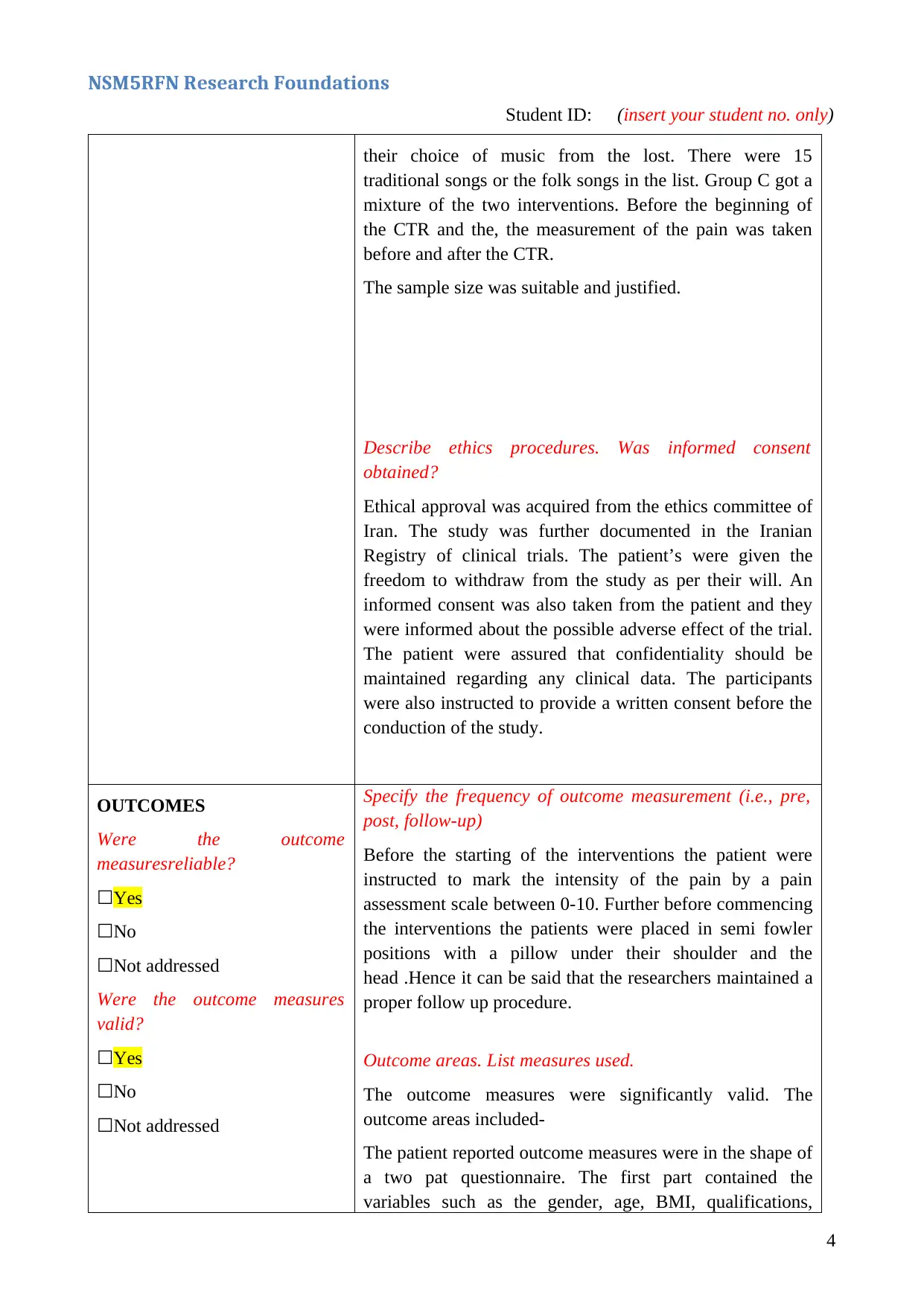
NSM5RFN Research Foundations
Student ID: (insert your student no. only)
their choice of music from the lost. There were 15
traditional songs or the folk songs in the list. Group C got a
mixture of the two interventions. Before the beginning of
the CTR and the, the measurement of the pain was taken
before and after the CTR.
The sample size was suitable and justified.
Describe ethics procedures. Was informed consent
obtained?
Ethical approval was acquired from the ethics committee of
Iran. The study was further documented in the Iranian
Registry of clinical trials. The patient’s were given the
freedom to withdraw from the study as per their will. An
informed consent was also taken from the patient and they
were informed about the possible adverse effect of the trial.
The patient were assured that confidentiality should be
maintained regarding any clinical data. The participants
were also instructed to provide a written consent before the
conduction of the study.
OUTCOMES
Were the outcome
measuresreliable?
☐Yes
☐No
☐Not addressed
Were the outcome measures
valid?
☐Yes
☐No
☐Not addressed
Specify the frequency of outcome measurement (i.e., pre,
post, follow-up)
Before the starting of the interventions the patient were
instructed to mark the intensity of the pain by a pain
assessment scale between 0-10. Further before commencing
the interventions the patients were placed in semi fowler
positions with a pillow under their shoulder and the
head .Hence it can be said that the researchers maintained a
proper follow up procedure.
Outcome areas. List measures used.
The outcome measures were significantly valid. The
outcome areas included-
The patient reported outcome measures were in the shape of
a two pat questionnaire. The first part contained the
variables such as the gender, age, BMI, qualifications,
4
Student ID: (insert your student no. only)
their choice of music from the lost. There were 15
traditional songs or the folk songs in the list. Group C got a
mixture of the two interventions. Before the beginning of
the CTR and the, the measurement of the pain was taken
before and after the CTR.
The sample size was suitable and justified.
Describe ethics procedures. Was informed consent
obtained?
Ethical approval was acquired from the ethics committee of
Iran. The study was further documented in the Iranian
Registry of clinical trials. The patient’s were given the
freedom to withdraw from the study as per their will. An
informed consent was also taken from the patient and they
were informed about the possible adverse effect of the trial.
The patient were assured that confidentiality should be
maintained regarding any clinical data. The participants
were also instructed to provide a written consent before the
conduction of the study.
OUTCOMES
Were the outcome
measuresreliable?
☐Yes
☐No
☐Not addressed
Were the outcome measures
valid?
☐Yes
☐No
☐Not addressed
Specify the frequency of outcome measurement (i.e., pre,
post, follow-up)
Before the starting of the interventions the patient were
instructed to mark the intensity of the pain by a pain
assessment scale between 0-10. Further before commencing
the interventions the patients were placed in semi fowler
positions with a pillow under their shoulder and the
head .Hence it can be said that the researchers maintained a
proper follow up procedure.
Outcome areas. List measures used.
The outcome measures were significantly valid. The
outcome areas included-
The patient reported outcome measures were in the shape of
a two pat questionnaire. The first part contained the
variables such as the gender, age, BMI, qualifications,
4
Paraphrase This Document
Need a fresh take? Get an instant paraphrase of this document with our AI Paraphraser
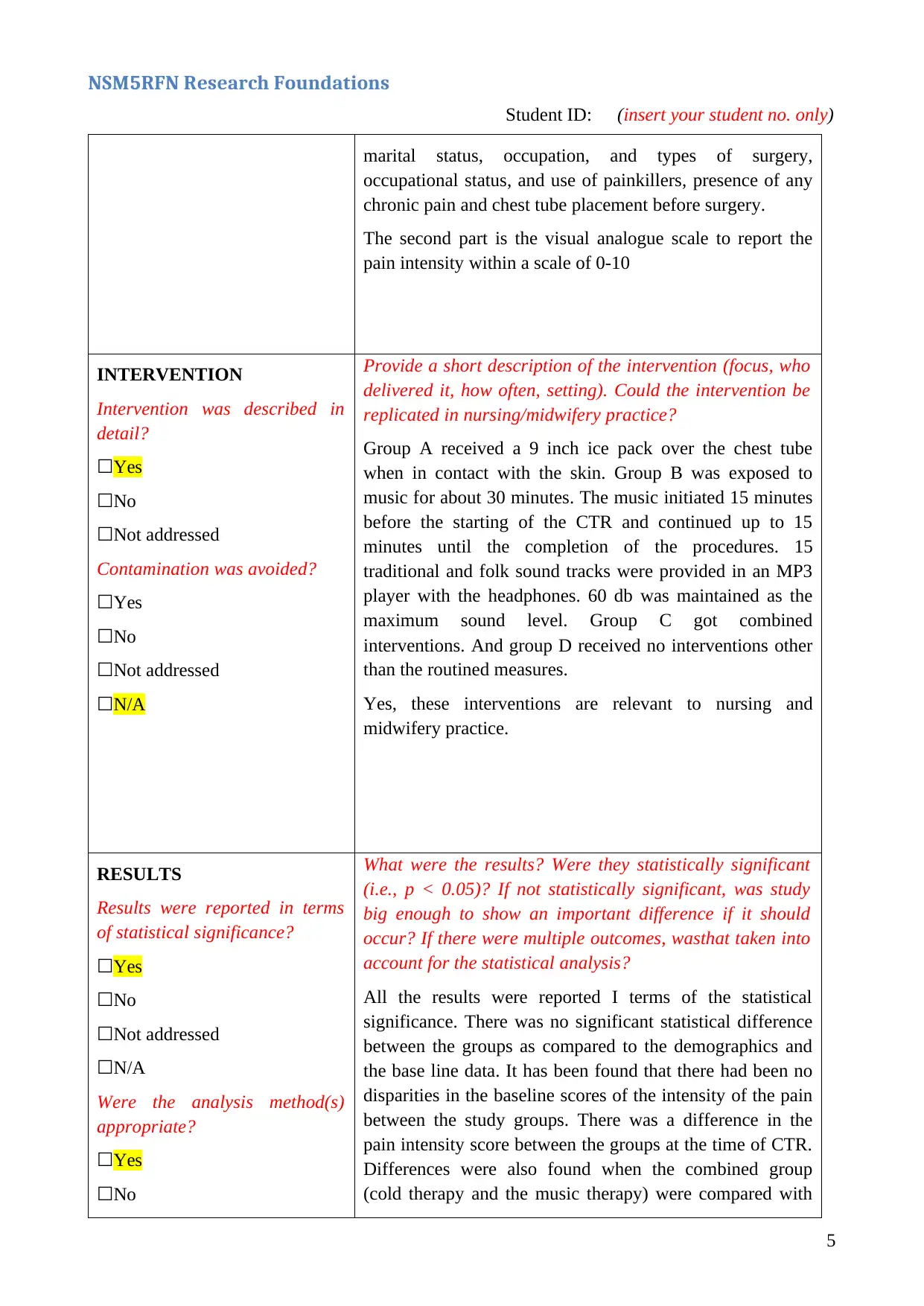
NSM5RFN Research Foundations
Student ID: (insert your student no. only)
marital status, occupation, and types of surgery,
occupational status, and use of painkillers, presence of any
chronic pain and chest tube placement before surgery.
The second part is the visual analogue scale to report the
pain intensity within a scale of 0-10
INTERVENTION
Intervention was described in
detail?
☐Yes
☐No
☐Not addressed
Contamination was avoided?
☐Yes
☐No
☐Not addressed
☐N/A
Provide a short description of the intervention (focus, who
delivered it, how often, setting). Could the intervention be
replicated in nursing/midwifery practice?
Group A received a 9 inch ice pack over the chest tube
when in contact with the skin. Group B was exposed to
music for about 30 minutes. The music initiated 15 minutes
before the starting of the CTR and continued up to 15
minutes until the completion of the procedures. 15
traditional and folk sound tracks were provided in an MP3
player with the headphones. 60 db was maintained as the
maximum sound level. Group C got combined
interventions. And group D received no interventions other
than the routined measures.
Yes, these interventions are relevant to nursing and
midwifery practice.
RESULTS
Results were reported in terms
of statistical significance?
☐Yes
☐No
☐Not addressed
☐N/A
Were the analysis method(s)
appropriate?
☐Yes
☐No
What were the results? Were they statistically significant
(i.e., p < 0.05)? If not statistically significant, was study
big enough to show an important difference if it should
occur? If there were multiple outcomes, wasthat taken into
account for the statistical analysis?
All the results were reported I terms of the statistical
significance. There was no significant statistical difference
between the groups as compared to the demographics and
the base line data. It has been found that there had been no
disparities in the baseline scores of the intensity of the pain
between the study groups. There was a difference in the
pain intensity score between the groups at the time of CTR.
Differences were also found when the combined group
(cold therapy and the music therapy) were compared with
5
Student ID: (insert your student no. only)
marital status, occupation, and types of surgery,
occupational status, and use of painkillers, presence of any
chronic pain and chest tube placement before surgery.
The second part is the visual analogue scale to report the
pain intensity within a scale of 0-10
INTERVENTION
Intervention was described in
detail?
☐Yes
☐No
☐Not addressed
Contamination was avoided?
☐Yes
☐No
☐Not addressed
☐N/A
Provide a short description of the intervention (focus, who
delivered it, how often, setting). Could the intervention be
replicated in nursing/midwifery practice?
Group A received a 9 inch ice pack over the chest tube
when in contact with the skin. Group B was exposed to
music for about 30 minutes. The music initiated 15 minutes
before the starting of the CTR and continued up to 15
minutes until the completion of the procedures. 15
traditional and folk sound tracks were provided in an MP3
player with the headphones. 60 db was maintained as the
maximum sound level. Group C got combined
interventions. And group D received no interventions other
than the routined measures.
Yes, these interventions are relevant to nursing and
midwifery practice.
RESULTS
Results were reported in terms
of statistical significance?
☐Yes
☐No
☐Not addressed
☐N/A
Were the analysis method(s)
appropriate?
☐Yes
☐No
What were the results? Were they statistically significant
(i.e., p < 0.05)? If not statistically significant, was study
big enough to show an important difference if it should
occur? If there were multiple outcomes, wasthat taken into
account for the statistical analysis?
All the results were reported I terms of the statistical
significance. There was no significant statistical difference
between the groups as compared to the demographics and
the base line data. It has been found that there had been no
disparities in the baseline scores of the intensity of the pain
between the study groups. There was a difference in the
pain intensity score between the groups at the time of CTR.
Differences were also found when the combined group
(cold therapy and the music therapy) were compared with
5
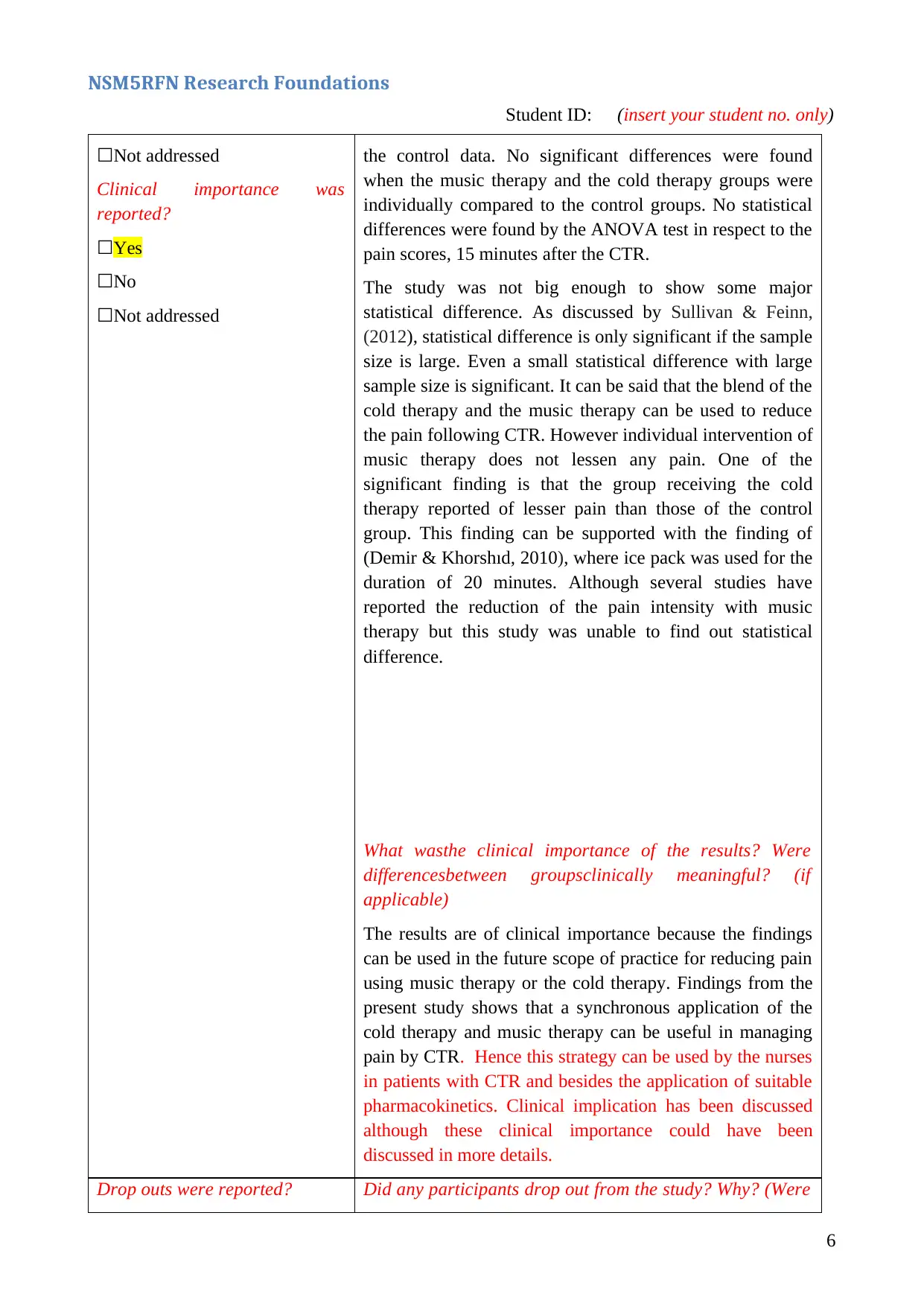
NSM5RFN Research Foundations
Student ID: (insert your student no. only)
☐Not addressed
Clinical importance was
reported?
☐Yes
☐No
☐Not addressed
the control data. No significant differences were found
when the music therapy and the cold therapy groups were
individually compared to the control groups. No statistical
differences were found by the ANOVA test in respect to the
pain scores, 15 minutes after the CTR.
The study was not big enough to show some major
statistical difference. As discussed by Sullivan & Feinn,
(2012), statistical difference is only significant if the sample
size is large. Even a small statistical difference with large
sample size is significant. It can be said that the blend of the
cold therapy and the music therapy can be used to reduce
the pain following CTR. However individual intervention of
music therapy does not lessen any pain. One of the
significant finding is that the group receiving the cold
therapy reported of lesser pain than those of the control
group. This finding can be supported with the finding of
(Demir & Khorshıd, 2010), where ice pack was used for the
duration of 20 minutes. Although several studies have
reported the reduction of the pain intensity with music
therapy but this study was unable to find out statistical
difference.
What wasthe clinical importance of the results? Were
differencesbetween groupsclinically meaningful? (if
applicable)
The results are of clinical importance because the findings
can be used in the future scope of practice for reducing pain
using music therapy or the cold therapy. Findings from the
present study shows that a synchronous application of the
cold therapy and music therapy can be useful in managing
pain by CTR. Hence this strategy can be used by the nurses
in patients with CTR and besides the application of suitable
pharmacokinetics. Clinical implication has been discussed
although these clinical importance could have been
discussed in more details.
Drop outs were reported? Did any participants drop out from the study? Why? (Were
6
Student ID: (insert your student no. only)
☐Not addressed
Clinical importance was
reported?
☐Yes
☐No
☐Not addressed
the control data. No significant differences were found
when the music therapy and the cold therapy groups were
individually compared to the control groups. No statistical
differences were found by the ANOVA test in respect to the
pain scores, 15 minutes after the CTR.
The study was not big enough to show some major
statistical difference. As discussed by Sullivan & Feinn,
(2012), statistical difference is only significant if the sample
size is large. Even a small statistical difference with large
sample size is significant. It can be said that the blend of the
cold therapy and the music therapy can be used to reduce
the pain following CTR. However individual intervention of
music therapy does not lessen any pain. One of the
significant finding is that the group receiving the cold
therapy reported of lesser pain than those of the control
group. This finding can be supported with the finding of
(Demir & Khorshıd, 2010), where ice pack was used for the
duration of 20 minutes. Although several studies have
reported the reduction of the pain intensity with music
therapy but this study was unable to find out statistical
difference.
What wasthe clinical importance of the results? Were
differencesbetween groupsclinically meaningful? (if
applicable)
The results are of clinical importance because the findings
can be used in the future scope of practice for reducing pain
using music therapy or the cold therapy. Findings from the
present study shows that a synchronous application of the
cold therapy and music therapy can be useful in managing
pain by CTR. Hence this strategy can be used by the nurses
in patients with CTR and besides the application of suitable
pharmacokinetics. Clinical implication has been discussed
although these clinical importance could have been
discussed in more details.
Drop outs were reported? Did any participants drop out from the study? Why? (Were
6
⊘ This is a preview!⊘
Do you want full access?
Subscribe today to unlock all pages.

Trusted by 1+ million students worldwide
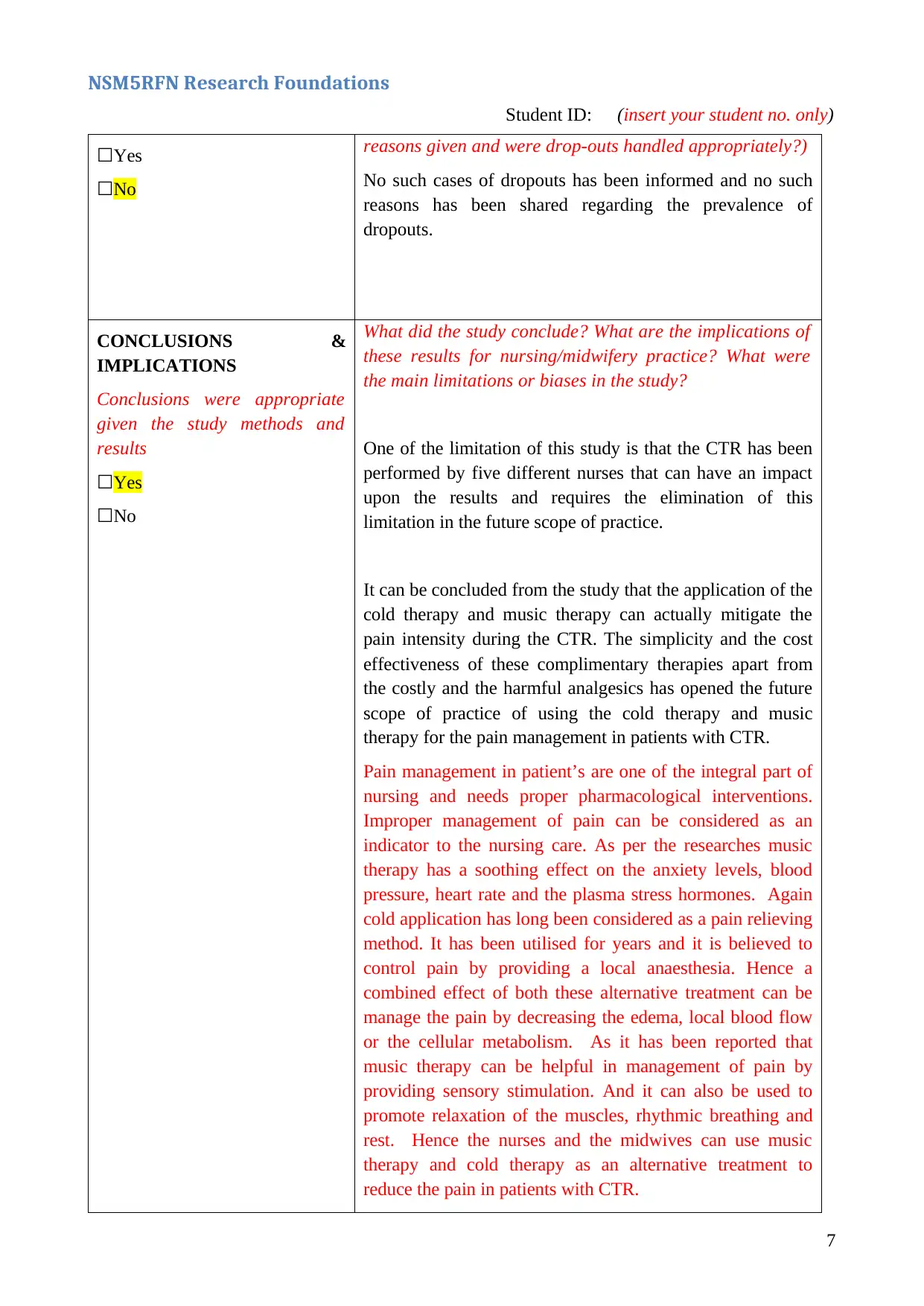
NSM5RFN Research Foundations
Student ID: (insert your student no. only)
☐Yes
☐No
reasons given and were drop-outs handled appropriately?)
No such cases of dropouts has been informed and no such
reasons has been shared regarding the prevalence of
dropouts.
CONCLUSIONS &
IMPLICATIONS
Conclusions were appropriate
given the study methods and
results
☐Yes
☐No
What did the study conclude? What are the implications of
these results for nursing/midwifery practice? What were
the main limitations or biases in the study?
One of the limitation of this study is that the CTR has been
performed by five different nurses that can have an impact
upon the results and requires the elimination of this
limitation in the future scope of practice.
It can be concluded from the study that the application of the
cold therapy and music therapy can actually mitigate the
pain intensity during the CTR. The simplicity and the cost
effectiveness of these complimentary therapies apart from
the costly and the harmful analgesics has opened the future
scope of practice of using the cold therapy and music
therapy for the pain management in patients with CTR.
Pain management in patient’s are one of the integral part of
nursing and needs proper pharmacological interventions.
Improper management of pain can be considered as an
indicator to the nursing care. As per the researches music
therapy has a soothing effect on the anxiety levels, blood
pressure, heart rate and the plasma stress hormones. Again
cold application has long been considered as a pain relieving
method. It has been utilised for years and it is believed to
control pain by providing a local anaesthesia. Hence a
combined effect of both these alternative treatment can be
manage the pain by decreasing the edema, local blood flow
or the cellular metabolism. As it has been reported that
music therapy can be helpful in management of pain by
providing sensory stimulation. And it can also be used to
promote relaxation of the muscles, rhythmic breathing and
rest. Hence the nurses and the midwives can use music
therapy and cold therapy as an alternative treatment to
reduce the pain in patients with CTR.
7
Student ID: (insert your student no. only)
☐Yes
☐No
reasons given and were drop-outs handled appropriately?)
No such cases of dropouts has been informed and no such
reasons has been shared regarding the prevalence of
dropouts.
CONCLUSIONS &
IMPLICATIONS
Conclusions were appropriate
given the study methods and
results
☐Yes
☐No
What did the study conclude? What are the implications of
these results for nursing/midwifery practice? What were
the main limitations or biases in the study?
One of the limitation of this study is that the CTR has been
performed by five different nurses that can have an impact
upon the results and requires the elimination of this
limitation in the future scope of practice.
It can be concluded from the study that the application of the
cold therapy and music therapy can actually mitigate the
pain intensity during the CTR. The simplicity and the cost
effectiveness of these complimentary therapies apart from
the costly and the harmful analgesics has opened the future
scope of practice of using the cold therapy and music
therapy for the pain management in patients with CTR.
Pain management in patient’s are one of the integral part of
nursing and needs proper pharmacological interventions.
Improper management of pain can be considered as an
indicator to the nursing care. As per the researches music
therapy has a soothing effect on the anxiety levels, blood
pressure, heart rate and the plasma stress hormones. Again
cold application has long been considered as a pain relieving
method. It has been utilised for years and it is believed to
control pain by providing a local anaesthesia. Hence a
combined effect of both these alternative treatment can be
manage the pain by decreasing the edema, local blood flow
or the cellular metabolism. As it has been reported that
music therapy can be helpful in management of pain by
providing sensory stimulation. And it can also be used to
promote relaxation of the muscles, rhythmic breathing and
rest. Hence the nurses and the midwives can use music
therapy and cold therapy as an alternative treatment to
reduce the pain in patients with CTR.
7
Paraphrase This Document
Need a fresh take? Get an instant paraphrase of this document with our AI Paraphraser

NSM5RFN Research Foundations
Student ID: (insert your student no. only)
8
Student ID: (insert your student no. only)
8
1 out of 8
Related Documents
Your All-in-One AI-Powered Toolkit for Academic Success.
+13062052269
info@desklib.com
Available 24*7 on WhatsApp / Email
![[object Object]](/_next/static/media/star-bottom.7253800d.svg)
Unlock your academic potential
Copyright © 2020–2025 A2Z Services. All Rights Reserved. Developed and managed by ZUCOL.





